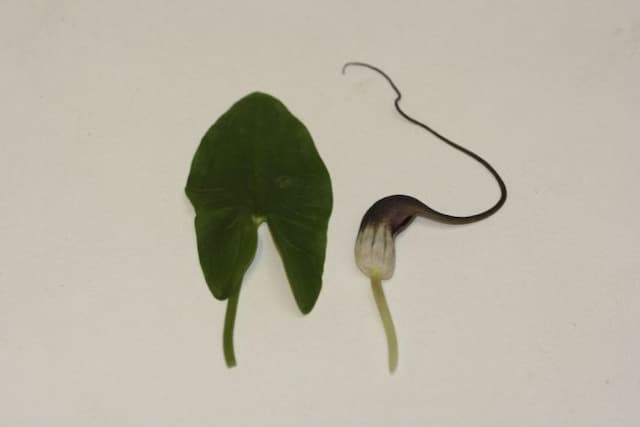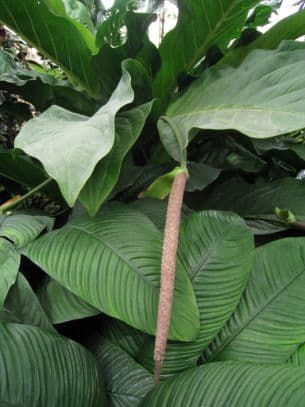Blushing Philodendron Philodendron erubescens 'Burgundy'

ABOUT
The Philodendron erubescens 'Burgundy', commonly referred to as the Burgundy Philodendron, is a striking houseplant known for its glossy, heart-shaped leaves. The leaves exhibit a rich, deep green color with Burgundy and sometimes almost purplish undertones, particularly on the undersides, which can give the plant a dramatic and luxurious appearance. The color tends to intensify to a darker burgundy as the leaves mature, adding to its visual allure. In addition to the unique coloring, the leaves of the Burgundy Philodendron have a certain sheen that catches the light, enhancing their aesthetic appeal. The contrast of the dark, lush foliage against the sometimes-visible reddish or deep burgundy stems only adds to the plant's beauty, making it a favored choice for indoor plant enthusiasts. Foliage tends to grow rather large and wide, which contributes to the plant's full and vibrant look. It's often sought after for its air-purifying qualities and the touch of tropical elegance it can add to an indoor space, much like others in the Philodendron family. As it grows, it may exhibit a climbing or spreading habit, and given the right conditions, it can be encouraged to trail or climb with the support of a moss pole or trellis. Overall, the Burgundy Philodendron is cherished for its lush foliage and striking coloration that can make it a centerpiece in plant collections or a luxurious addition to home décor.
About this plant
 Names
NamesSynonyms
Red-leaf Philodendron, Blushing Philodendron, Burgundy Philodendron, Imperial Red Philodendron, Red Emerald Philodendron.
Common names
Philodendron erubescens.
 Toxicity
ToxicityTo humans
The Blushing Philodendron is toxic to humans if ingested. It contains calcium oxalate crystals which, when chewed or swallowed, can lead to irritation of the mouth, lips, tongue, and throat. Symptoms of poisoning may include a burning sensation, swelling, difficulty swallowing, and in severe cases breathing difficulties due to the swelling. It is important to prevent ingestion, especially in children and pets.
To pets
The Blushing Philodendron is also toxic to pets, including cats and dogs. Similar to its effects on humans, the calcium oxalate crystals in the plant can cause oral irritation, intense burning and irritation of the mouth, tongue, and lips, excessive drooling, vomiting, and difficulty swallowing if ingested by pets. In severe cases, ingestion can lead to respiratory issues due to swelling of the airways. It is important to keep the plant out of reach from pets to avoid accidental ingestion.
 Characteristics
CharacteristicsLife cycle
Perennials
Foliage type
Evergreen
Color of leaves
Burgundy
Height
3-6 feet (0.9-1.8 meters)
Spread
2-3 feet (0.6-0.9 meters)
Plant type
Climber
Hardiness zones
10
Native area
Central America
Benefits
 General Benefits
General Benefits- Visual Appeal: Enhances interior design with its attractive burgundy-hued foliage and tropical look.
- Low Maintenance: Requires minimal care, can thrive with infrequent watering and moderate light conditions.
- Growth Habit: Can be trained to climb or allowed to cascade, offering versatility in landscaping and indoor decoration.
- Mood Enhancer: Presence of plants like the Philodendron can boost mood and contribute to a calming environment.
- Improves Humidity: By releasing water vapor during transpiration, it helps maintain indoor humidity levels, which can be beneficial in dry climates.
- Thermal Comfort: The plant’s foliage can contribute to a slight reduction of ambient temperature through the process of evapotranspiration.
 Medical Properties
Medical PropertiesThis plant is not used for medical purposes.
 Air-purifying Qualities
Air-purifying QualitiesThis plant is not specifically known for air purifying qualities.
 Other Uses
Other Uses- Creative Art Projects: Leaves of the Philodendron erubescens 'Burgundy' can be used for making leaf prints in art, due to their unique shape and structure.
- Photography Subject: The vibrant burgundy and green colors of the leaves are often used as a compelling subject in macro and botanical photography.
- Fashion Inspiration: The distinctive color palette and patterns of the leaves are used by fashion designers as inspiration for textile patterns and designs.
- Color Therapy: The deep burgundy hues can be used in color therapy setups to create a sense of warmth and sophistication in interior spaces.
- Educational Tool: This plant can be used in biology classes to help students learn about tropical plants and their growth habits.
- Sound Absorption: Due to its dense foliage, the plant can help absorb sound in loud spaces, which could be an unusual use in office spaces or studios.
- Culinary Presentation: Although not edible, the leaves can be used as a natural decorative platter for presenting food at upscale events.
- Mood Setting: Its lush and exotic appearance makes it suitable for use in spa or relaxation areas to help set a calming mood.
- Theme Decorations: The plant can be incorporated into themed party decorations where a jungle or tropical ambiance is desired.
- Craft Material: Dried or pressed leaves of the plant can be used in crafting, such as in scrapbooking or making homemade cards.
Interesting Facts
 Feng Shui
Feng ShuiIn Feng Shui, the Red-Leaf Philodendron is believed to bring positive energy due to its lush, upward-growing foliage, which can add life and vibrancy to a space. Place it in the wealth area of your home, usually the southeast corner, to stimulate financial prosperity or in the family area, the east, to promote health and balance. Its vibrant green leaves with burgundy undertones are thought to represent growth and the wood element, which can harmonize the flow of chi in your environment.
 Zodiac Sign Compitability
Zodiac Sign CompitabilityThe Red-Leaf Philodendron is not used in astrology practice.
 Plant Symbolism
Plant Symbolism- Growth - Philodendron, in general, symbolizes growth and development due to its natural propensity to climb and expand in its environment.
- Health - The lush greenery of the Blushing Philodendron ('Burgundy') represents good health and vitality.
- Longevity - This plant can live for many years with proper care, thus embodying the idea of longevity and perseverance.
- Prosperity - The Blushing Philodendron is often associated with prosperity and abundance, as it has a full, rich appearance.
- Love of Nature - Due to its tropical origins, the plant epitomizes a love for nature and the natural world.
 Water
WaterThe Red Emerald Philodendron should be watered when the top inch of soil feels dry to the touch, roughly every 7 to 10 days, but this can vary depending on environmental factors such as light and humidity. Pour water evenly around the base of the plant until it begins to drain from the bottom of the pot, which typically takes about 16 to 32 onzes for a medium-sized pot. Avoid letting the plant sit in standing water, and reduce watering in the winter months when the plant's growth slows down.
 Light
LightThe Red Emerald Philodendron thrives in medium to bright, indirect light, making an east or north-facing window an ideal spot. Direct sunlight can scorch its leaves, so it’s best to provide filtered or dappled light. If positioned too far from a light source, the plant can become leggy as it stretches towards the light.
 Temperature
TemperatureThe Red Emerald Philodendron prefers a temperature range between 65 and 80 degrees Fahrenheit and can tolerate a minimum of 55 degrees Fahrenheit. Avoid placing the plant in areas with drafts, sudden temperature changes, or near heating and cooling vents. The ideal conditions are warm and stable environments mimicking its native tropical climate.
 Pruning
PruningPruning the Red Emerald Philodendron promotes bushier growth and removes any yellow or dead leaves to maintain its aesthetics. Prune sparingly, only when necessary, and during the spring or summer for the best recovery. Sterilized pruning shears should be used to make clean cuts without damaging the stems.
 Cleaning
CleaningAs needed
 Soil
SoilThe Red Emerald Philodendron thrives in a well-draining potting mix with peat, perlite, and pine bark. Aim for a soil pH of 5.0 to 6.0 for optimal growth.
 Repotting
RepottingThe Red Emerald Philodendron should be repotted every 2-3 years to prevent it from becoming root-bound and to refresh the soil.
 Humidity & Misting
Humidity & MistingThe Red Emerald Philodendron prefers a humidity level of 60-80% for healthy growth and development.
 Suitable locations
Suitable locationsIndoor
Place in bright, indirect light and keep soil moist.
Outdoor
Provide shade, moist soil, and protection from cold.
Hardiness zone
9b-11 USDA
 Life cycle
Life cycleThe life cycle of Philodendron erubescens 'Burgundy', commonly known as Red-leaf Philodendron, begins with seed germination, where warmth and moisture trigger the development of the seed into a seedling. The seedling stage involves initial leaf development and root establishment. As the plant enters the juvenile stage, it develops a more robust root system and larger leaves with characteristic red to purple undertones which develop as the plant matures. The adult stage is marked by the plant's readiness to reproduce, where it can develop inflorescences that are characteristic of the Araceae family, although flowering is rare when cultivated indoors. After pollination, the plant can produce berries containing seeds, allowing for the next generation to begin the life cycle anew. Throughout its life, the Red-leaf Philodendron will continue to grow larger, and it can be propagated vegetatively via stem cuttings, which will root and grow into new plants.
 Propogation
PropogationPropogation time
Spring to Summer
Propogation: The most popular method of propagating the Philodendron erubescens 'Burgundy', commonly known as the Red-Leaf Philodendron, is through stem cuttings. To propagate, a healthy stem cutting with at least two nodes should be selected. The cutting is then placed in water or moist potting soil, ensuring that at least one node, where the leaves meet the stem, is submerged. Roots will typically develop from the submerged nodes. This process is usually more successful during the warm growing season, preferably spring or early summer, as the warmth stimulates root growth. Once the roots are about 1 to 2 inches (2.5 to 5 centimeters) long, the cutting can be transferred to soil where it can continue growing into a new, independent plant.









